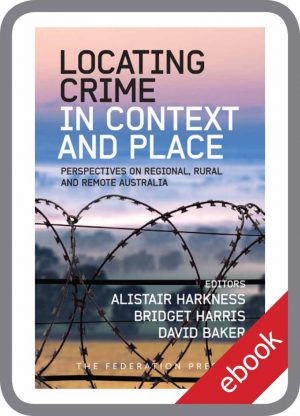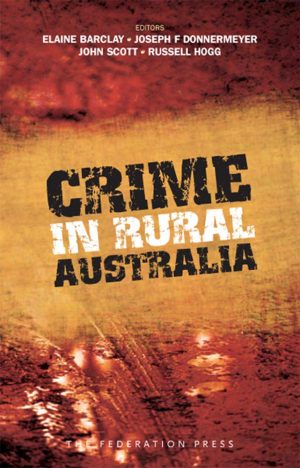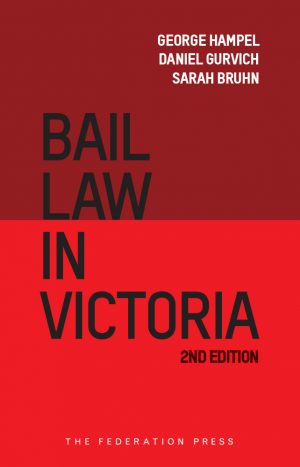The urban focus of crime has dominated the attention of criminologists. Although images of idyllic, crime-free areas beyond the cityscape persist, there is scant academic consideration of the realities and variances of crime across regional, rural and remote Australia.
Contributors to Locating Crime explore the nexus between crime and space, examining the complexities that exist in policing, prosecuting and punishing crime in different zones. The various authors draw upon original knowledge and insight and utilise innovative research and an interdisciplinary approach to their work.
The broad theme of Locating Crime is centred on ‘context, place and space’, but several sub-themes emerge too. Contributors grapple with a number of issues: contextualisations of rurality; notions of ‘access to justice’; the importance of building ‘social capital’; the role of history; and of proactively addressing offending rates with crime prevention measures. This original research adds significantly to criminological understandings of crime in different spaces and offers novel insights of the impact upon victims and communities affected by crime in non-urban environments.
Twelve scholarly chapters are grounded in criminological, legal and socio-legal frameworks and incorporate theoretical and practical knowledge from other fields such as history, sociology, cultural geography, media, cultural studies and Indigenous studies. The contributions from four professionals with expert knowledge of specific facets of criminal justice systems in Australia offer evaluations often absent from scholarly criminological literature. By melding both academic and practitioner discourse into the same work, this book allows a greater appreciation of the nexus between thought and practice.
Foreword by Elaine Barclay
Notes on Contributors
List of Figures and Tables
Common Acronyms
Introduction: Locating Regional, Rural and Remote Crime in Theoretical and Contemporary Context
Bridget Harris and Alistair Harkness
PART A: LOCATING CRIME
1. An Interpretive Approach to Understanding Crime in Rural Australia
John Scott and Dean Biron
2. Placing Crime: The Failings of Urban-Centric Environmental Criminology
Murray Lee and Garner Clancy
3. Development of Crime and the Criminal Justice System in Australia
Jenny Wise and David Andrew Roberts
4. Crime Patterns: Measurement and Evaluation of Crime and Deviance in Rural and Regional Australia
Frank Morgan
PART B: CRIMINAL JUSTICE ISSUES AND RESPONSES
5. The Place of Indigenous People: Locating Crime and Criminal Justice in a Colonising World
Chris Cunneen
6. Violent Landscapes: A Spatial Study of Family Violence
Bridget Harris
7. Policing of Protest in Rural and Regional Contexts
David Baker
8. Farm Crime: The Forgotten Frontier?
Alistair Harkness
9. Accessing Justice in Regional Australia: Evolving Perspectives and Contexts
Richard Coverdale
10. Witness, Judge or Watchdog?: Journalism and Regional Courts
Kristy Hess and Lisa Waller
11. Penology from City to Country: Rurality and Penality in Australia
Russell Hogg
12. Crime Prevention in Varied Settings
Anthony Morgan
PART C: PRACTITIONER PERSPECTIVES
13. Broadmeadows to the Bush: A Policing Perspective
Robert Haldane
14. Law and True Justice: A Perspective from the Top End
Jonathon Hunyor
15. Bush Courts and Beyond
Jenny Blokland
16. Lawmaking or Making Justice?: Foundations for Criminal Justice Responses in Rural and Regional Communities
Rob Hulls
17. Conclusion: The State of Play
David Baker
References
Index
In many ways, Australia is a living laboratory for the study of rural crime. Physically, the country is enormous, but, as the book’s introduction notes “ … 90.5 per cent of the population resides on 0.22 percent of Australia’s land area” (p. 6). As is true in the United States (US) and Canada, Australia’s rural areas are also home to a substantial number of native/Aboriginal people who receive fewer social services than urban residents, but attract higher attention from criminal justice authorities. Although many issues raised in this book match research in other countries, particularly the US, Canada and Great Britain, several authors take pain to describe the importance of Australia’s unique history and remind readers of differences among rural areas in Australia.
Each of the 20 authors or co-authors works in Australia and, as such, provide insights that might be missed by outsiders. Many of the authors they cite are also Australian. Thus, the book reminds the reader of the volume of research on rural crime in Australia and the number of individuals who have taken up the study of this subject. … One unique feature of the book is the closing section where criminal justice practitioners who have worked in rural Australia do a splendid job sharing observations about the challenges and unique opportunities afforded by rural settings and articulating issues, putting a human face on the broader issues described by academics in previous chapters. Read full review…
Ralph Weisheit, Rural Society, February 2017
The scholars and practitioners who have contributed to this text examine the existing criminal justice responses to crime in regional, rural and remote areas of Australia and identify areas for improvement.
In her Foreword, Elaine Barclay (Associate Professor in Criminology at the University of New England) identifies that while 74 per cent of Australia’s population is concentrated within capital cities, the remainder of the population is scattered across a vast regional, rural and remote area. A common thesis that can be deduced from each contribution is that it is important for policy makers, practitioners, researchers and students to appreciate the diversity that exists among regional communities when considering responses to crime and other social problems in regional areas.
The book is divided into three parts; Part A: Locating Crime, Part B: Criminal Justice Issues and Responses and Part C: Practitioner Perspectives. Part A includes comparisons of rates and types of crime. Parts B and C examine issues including the over-representation of Indigenous people within the criminal justice system, difficulties experienced in policing small rural areas and the best ways to effectively administer and deliver justice in rural and remote areas.
I commend this book to policy makers, practitioners, researchers and students who seek to understand the nuanced responses to crime required in regional, rural and remote Australia.
Queensland Law Reporter – 15 September 2017 – [2017] 36 QLR
The book highlights the inequalities and the diversity that rural communities experience, particularly, in relation to crime and access to justice. It is interesting to note, as expressed in the Foreword by Elaine Barclay, that issues concerning access to justice are unlikely to change due to the current service delivery models which have been designed with the emphasis upon urban areas and with little focus on rural populations.
Locating Crime brings together a number of experts in the field of criminology who have added to the veracity of the text through their individual and collective expertise. The book is written and constructed in such a way and language that enables readers of all levels of knowledge and expertise to be able to understand and interpret the various issues and concepts that the book discusses.
The book would not only be a valuable contribution to the library of practitioners. It is likely to be of great benefit for anybody with an interest in criminology including policy makers, researchers and students.
In short, Locating Crime is an interesting and enlightening read. Read review…
James McNab, Hearsay, November, 77
This collection of articles on the nexus between place and crime is highly informative and would be of particular use to any criminal justice practitioners whose work encompasses regional, rural and remote (RRR) communities. However the collection has a much wider relevance. With 90% of the population concentrated in just 0.22% of the land area of Australia (to cite just one of the many startling pieces of information in the collection), the implications of this “distinctive Australian socio-spatial context” for the practical attainment of equality before the law are also addressed.
Many eminent academics and practitioners have contributed to this broad ranging collection. It includes analysis and critical commentary on access to justice, crime rates and prevention, policing, the criminalisation of Indigenous Australians, family violence, punishment and rehabilitation programs, farm crime and media reporting from the perspective of RRR Australia. …
Some 60 years ago the “tyranny of distance” was first used to describe the effect of our geographical remoteness from our colonial forebears and the unique development of Australia… Interestingly, this phrase is also indicative of a habit of thinking about place; that is, by reference to somewhere else, rather than the place itself. An overriding message of this collection is that the “tyranny of distance” continues to impose burdens on RRR communities, including the failure to deliver structures and resourcing to ensure equal access to justice for RRR Australia. While we allow “rural communities [to remain] imagined communities”, devoid of specific data, community input and control, we will continue to fail to deliver equal justice to the members of those communities. This collection makes an important contribution by replacing imagined rural communities with real information, and identifying the gaps in our knowledge of these communities. Read full review…
Hon Wayne Martin AC, Australian Law Journal, 2016, 90






